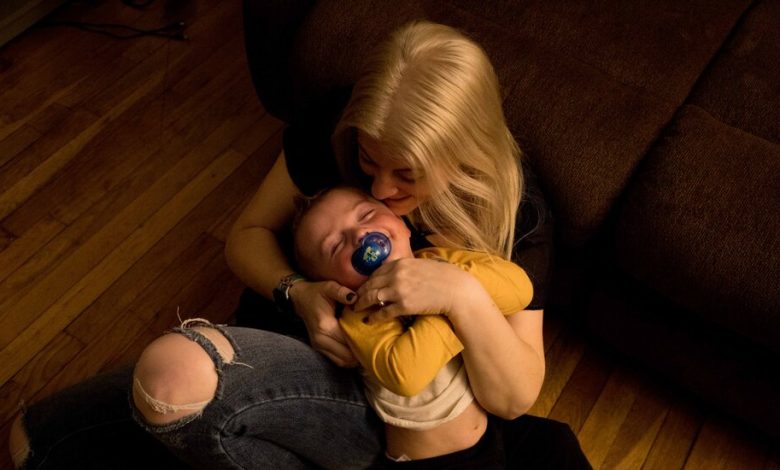Covid Worsened a Health Crisis Among Pregnant Women

KOKOMO, Ind. — Tammy Cunningham doesn’t remember the birth of her son. She was not quite seven months pregnant when she became acutely ill with Covid-19 in May 2021. By the time she was taken by helicopter to an Indianapolis hospital, she was coughing and gasping for breath.
The baby was not due for another 11 weeks, but Ms. Cunningham’s lungs were failing. The medical team, worried that neither she nor the fetus would survive so long as she was pregnant, asked her fiancé to authorize an emergency C-section.
“I asked, ‘Are they both going to make it?’” recalled Matt Cunningham. “And they said they couldn’t answer that.”
New government data suggest that scenes like this played out with shocking frequency in 2021, the second year of the pandemic.
The National Center for Health Statistics reported on Thursday that 1,205 pregnant women died in 2021, representing a 40 percent increase in maternal deaths compared with 2020, when there were 861 deaths, and a 60 percent increase compared with 2019, when there were 754.
The count includes deaths of women who were pregnant or had been pregnant within the last 42 days, from any cause related to or aggravated by the pregnancy. A separate report by the Government Accountability Office has cited Covid as a contributing factor in at least 400 maternal deaths in 2021, accounting for much of the increase.

Matt and Tammy Cunningham with their son, Calum.Credit…Kaiti Sullivan for The New York Times
Even before the pandemic, the United States had the highest maternal mortality rate of any industrialized nation. The coronavirus worsened an already dire situation, pushing the rate to 32.9 per 100,000 births in 2021 from 20.1 per 100,000 live births in 2019.
The racial disparities have been particularly acute. The maternal mortality rate among Black women rose to 69.9 deaths per 100,000 live births in 2021, 2.6 times the rate among white women. From 2020 to 2021, mortality rates doubled among Native American and Alaska Native women who were pregnant or had given birth within the previous year, according to a study published on Thursday in Obstetrics & Gynecology.
The deaths tell only part of the story. For each woman who died of a pregnancy-related complication, there were many others, like Ms. Cunningham, who experienced the kind of severe illness that leads to premature birth and can compromise the long-term health of both mother and child. Lost wages, medical bills and psychological trauma add to the strain.
Pregnancy leaves women uniquely vulnerable to infectious diseases like Covid. The heart, lungs and kidneys are all working harder during pregnancy. The immune system, while not exactly depressed, is retuned to accommodate the fetus.
More on the Coronavirus Pandemic
- Covid’s Origins: A House subcommittee opened its first public hearing on the possible origins of the pandemic, including a lab leak theory that’s the subject of intense political and scientific debate.
- Covid Testing: The Biden administration appears to be planning to end a requirement that travelers coming from China present a negative Covid-19 test before entering the United States.
- Long Covid: A large study found that Covid patients were significantly more likely to experience gastrointestinal problems a year after infection than people who were not infected.
- New Drug’s Long Odds: A promising new treatment quashes all Covid variants, but regulatory hurdles and a lack of funding make it unlikely to reach the United States market anytime soon.
Abdominal pressure reduces excess lung capacity. Blood clots more easily, a tendency amplified by Covid, raising the risk of dangerous blockages. The infection also appears to damage the placenta, which delivers oxygen and nutrients to the fetus, and may increase the risk of a dangerous complication of pregnancy called pre-eclampsia.
Pregnant women with Covid face a sevenfold risk of dying compared with uninfected pregnant women, according to one large meta-analysis tracking unvaccinated people. The infection also makes it more likely that a woman will give birth prematurely and that the baby will require neonatal intensive care.
Fortunately, the current Omicron variant appears to be less virulent than the Delta variant, which surfaced in the summer of 2021, and more people have acquired immunity to the coronavirus by now. Preliminary figures suggest maternal deaths dropped to roughly prepandemic levels in 2022.
But pregnancy continues to be a factor that makes even young women uniquely vulnerable to severe illness. Ms. Cunningham, now 39, who was slightly overweight when she became pregnant, had just been diagnosed with gestational diabetes when she got sick.
“It’s something I talk to all my patients about,” said Dr. Torri Metz, a maternal fetal medicine specialist at the University of Utah. “If they have some of these underlying medical conditions and they’re pregnant, both of which are high-risk categories, they have to be especially careful about putting themselves at risk of exposure to any kind of respiratory virus, because we know that pregnant people get sicker from those viruses.”
Lagging Vaccination
In the summer of 2021, scientists were somewhat unsure of the safety of mRNA vaccines during pregnancy; pregnant women had been excluded from the clinical trials, as they often are. It was not until August 2021 that the Centers for Disease Control and Prevention came out with unambiguous guidance supporting vaccination for pregnant women.
Most of the pregnant women who died of Covid had not been vaccinated. These days, more than 70 percent of pregnant women have gotten Covid vaccines, but only about 20 percent have received the bivalent boosters.
“We know definitively that vaccination prevents severe disease and hospitalization and prevents poor maternal and infant outcomes,” said Dr. Dana Meaney-Delman, chief of the C.D.C.’s infant outcomes monitoring, research and prevention branch. “We have to keep emphasizing that point.”
Ms. Cunningham’s obstetrician had encouraged her to get the shots, but she vacillated. She was “almost there” when she suddenly started having unusually heavy nosebleeds that produced blood clots “the size of golf balls,” she said.
Ms. Cunningham was also feeling short of breath, but she ascribed that to the advancing pregnancy. (Many Covid symptoms can be missed because they resemble those normally occurring in pregnancy.)
A Covid test came back negative, and Ms. Cunningham was happy to return to her job. She had already lost wages after earlier pandemic furloughs at the auto parts plant where she worked. On May 3, 2021, shortly after clocking in, she turned to a friend at the plant and said, “I can’t breathe.”
By the time she arrived at IU Health Methodist Hospital in Indianapolis, she was in acute respiratory distress. Doctors diagnosed pneumonia and found patchy shadows in her lungs.
Her oxygen levels continued falling even after she was put on undiluted oxygen, and even after the baby was delivered.
“It was clear her lungs were extremely damaged and unable to work on their own,” said Dr. Omar Rahman, a critical care physician who treated Ms. Cunningham. Already on a ventilator, Ms. Cunningham was connected to a specialized heart-lung bypass machine.
Jennifer McGregor, a friend who visited Ms. Cunningham in the hospital, was shocked at how quickly her condition had deteriorated. “I can’t tell you how many bags were hanging there, and how many tubes were going into her body,” she said.
But over the next 10 days, Ms. Cunningham started to recover. Once she was weaned off the heart-lung machine, she discovered she had missed a major life event while under sedation: She had a son.
He was born 29 weeks and two days into the pregnancy, weighing three pounds.
Premature births declined slightly during the first year of the pandemic. But they rose sharply in 2021, the year of the Delta surge, reaching the highest rate since 2007.
Some 10.5 percent of all births were preterm that year, up from 10.1 percent in 2020, and from 10.2 percent in 2019, the year before the pandemic.
Though the Cunninghams’ baby, Calum, never tested positive for Covid, he was hospitalized in the neonatal intensive care unit at Riley Hospital for Children in Indianapolis. He was on a breathing tube, and occasionally stopped breathing for seconds at a time.
Doctors worried that he was not gaining weight quickly enough — “failure to thrive,” they wrote in his chart. They worried about possible vision and hearing loss.
But after 66 days in the NICU, the Cunninghams were able to take Calum home. They learned how to use his feeding tube by practicing on a mannequin, and they prepared for the worst.
“From everything they told us, he was going to have developmental delays and be really behind,” Mr. Cunningham said.
After her discharge from the hospital, Ms. Cunningham was under strict orders to have a caretaker with her at all times and to rest. She didn’t return to work for seven months, after she finally secured her doctors’ approval.
Ms. Cunningham has three teenage daughters, and Mr. Cunningham has another daughter from a previous relationship. Money was tight. Friends dropped off groceries, and the landlord accepted late payments. But the Cunninghams received no government aid: They were even turned down for food stamps.
“We had never asked for assistance in our lives,” Ms. Cunningham said. “We were workers. We used to work seven days a week, eight-hour days, sometimes 12. But when the whole world shut down in 2020, we used up a lot of our savings, and then I got sick. We never got caught up.”
Though she is back to work at the plant, Ms. Cunningham has lingering symptoms, including migraines and short-term memory problems. She forgets doctor’s appointments and what she went to the store for. Recently she left her card in an A.T.M.
Many patients are so traumatized by their stays in intensive care units that they develop so-called post-intensive care syndrome. Ms. Cunningham has flashbacks and nightmares about being back in the hospital.
“I wake up feeling like I’m being smothered at the hospital, or that they’re killing my whole family,” she said. Recently she was diagnosed with post-traumatic stress disorder.
Calum, however, has surprised everyone. Within months of coming home from the hospital, he was reaching developmental milestones on time. He started walking soon after his first birthday, and likes to chime in with “What’s up?” and “Uh-oh!”
He has been back to the hospital for viral infections, but his vocabulary and comprehension are superb, his father said. “If you ask if he wants a bath, he’ll take off all his clothes and meet you at the bath,” he said.
Louann Gross, who owns the day care that Calum attends, said he has a hearty appetite — often asking for “thirds” — and more than keeps up with his peers. She added, “I nicknamed him our ‘Superbaby.’”




